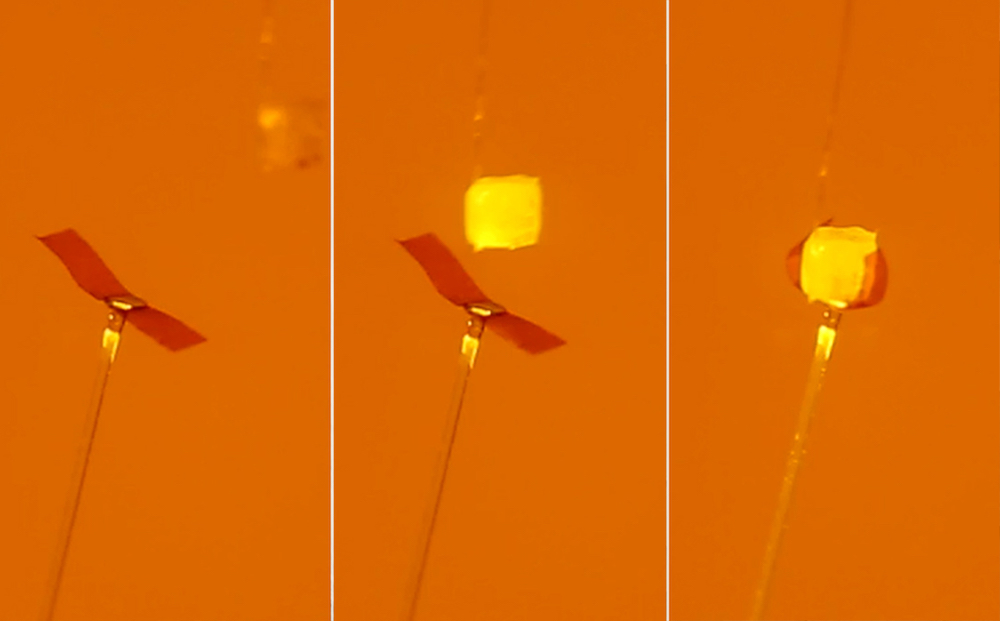Robo-Venus Flytrap Could Help Bots Grasp Objects

An artificial Venus flytrap can open and then close on cue, just like its namesake in nature, according to a new study. Scientists said this flexible gripping device could give soft robots a way to grasp and release objects autonomously, without the need for programming or computer-controlled parts.
"If you want to make something intelligent, oftentimes it's made using computers and some control circuitry that incorporates sensors and detectors. You have a system with many different pieces that have to be integrated to make the device work," said the study’s lead researcher Arri Priimagi, an associate professor of chemistry and bioengineering at Tampere University of Technology in Finland. [Biomimicry: 7 Clever Technologies Inspired by Nature]
The team tried to make this simpler he told Live Science.
Priimagi and his colleagues described their device in a study published online today (May 23) in the journal Nature Communications.
Although the device could serve in a range of applications, from biomedical manipulators to microchip-assembly lines to warehouse robots that stock shelves, Priimagi said he hasn't devoted much time to thinking about how the technology might be used.
"This wasn't application-driven," he said.
In nature, the carnivorous Venus flytrap waits with its jaw-like leaves open until an insect descends to drink from a nectar gland inside the plant. Last year, a study published in the journal Current Biology by researchers at the University of Würzburg in Germany, showed that the plant doesn't react instantly if a fly lands on it. Instead, hair-like sensors inside the flytraps' leaves need to be triggered twice in 20 seconds for the jaws to close, and five times to trigger the production of digestive enzymes, the scientists found.
Sign up for the Live Science daily newsletter now
Get the world’s most fascinating discoveries delivered straight to your inbox.
Priimagi's gripper doesn't trap or ingest insects, but it does use a stimulus in order to close its trap, he said. What's more, the power source, sensors and devices that convert energy into motion are combined into one simple device.
The device has two main components: an optical fiber stem and a leaf made from a light-responsive liquid crystal elastomer. When open, the leaf and the fiber form a capital letter "T."
When light in the fiber-optic stem shines up through the leaf and out into the air, it creates a cone-shaped beam. If an object passes into the beam, light scatters back to the bendy leaf, triggering molecules inside the material that respond by changing shape. This changing of shape generates heat, causing the molecules to misalign, and this creates a bend in the elastomer. The leaf closes, opening when the light is turned off.
The leaf is tiny: a strip measuring no longer than 0.4 inches (1 centimeter) and thinner than a strand of human hair. But because it's made of soft material that becomes even softer when it heats up a bit, the leaf's gripping strength is high, the researchers said. It's able to grasp objects that have a mass hundreds of times higher than itself, the scientists added.
In lab experiments, the team showed that the device could grab objects of any shape, including round or square objects, as well as random bits of Styrofoam and thin sheets covered with reflective material, such as aluminum foil. The scientists used lasers for the study, but Priimagi said they could do the same with LEDs or even with white light.
"We just need light and optical fibers," he said.
Priimagi said his team has more work to do, such as experimenting with different colors of light, finding ways to move heavier objects and making the device snap shut more quickly, the way a real Venus flytrap does.
Original article on Live Science.











